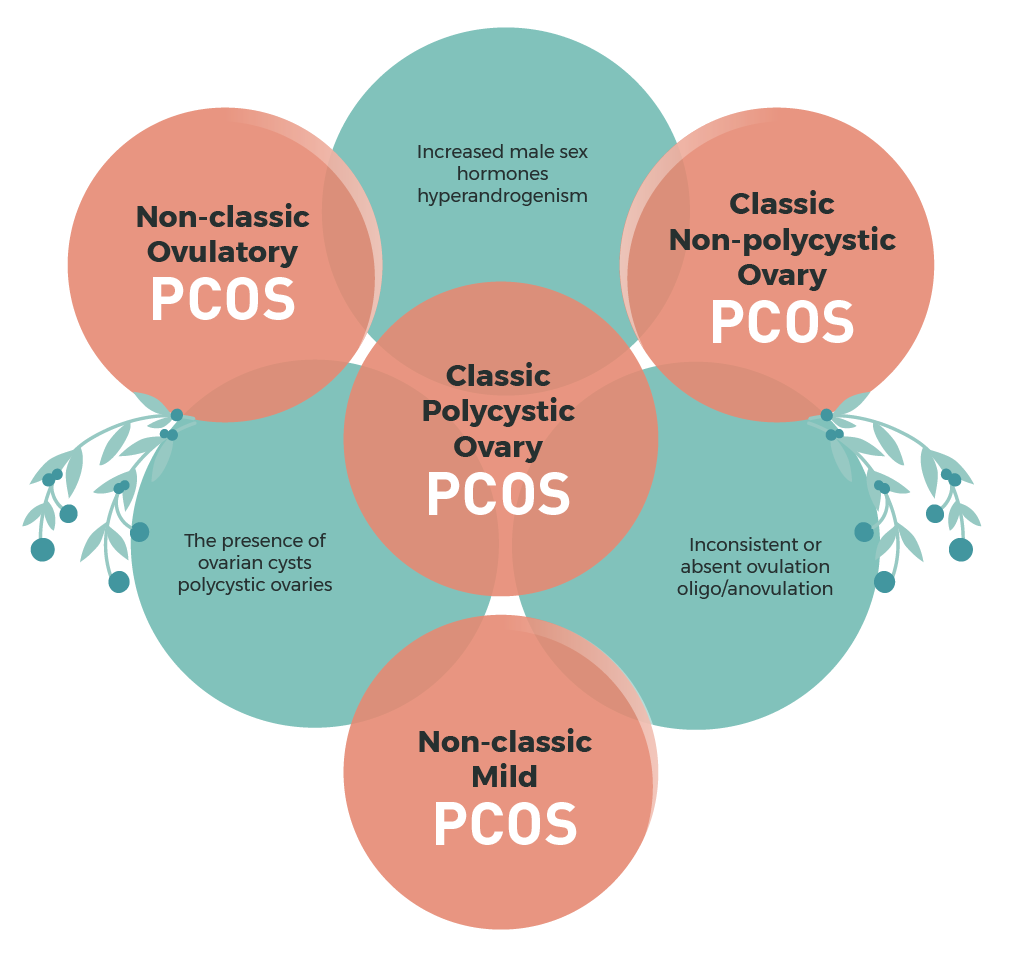People with PCOS share many similar experiences, yet there is quite a bit of variation among the PCOS experience.
Why do people with PCOS have different symptoms?
Why is there body diversity among the PCOS community if we all have the same condition?
Will the same medications help everyone?
The questions are endless!
Research has demonstrated people with PCOS can be separated in four different categories depending on three basic PCOS symptoms:
- inconsistent and/or lack of ovulation (oligo/anovulation),
- increased male sex hormones (hyperandrogenism),
- and the presence of cysts on ovaries (polycystic ovaries).
Yes, you read that correctly, having cysts on your ovaries is not a requirement to having PCOS. One study identified the following four types of PCOS, and these four types have built the foundation for understanding the general differences between people with PCOS:
Since these types of PCOS were identified many researchers examined what other symptoms vary between the types.
The classic polycystic ovary PCOS is the most prevalent type of PCOS, and, unfortunately, it is associated with the most negative health outcomes. People with this type of PCOS are more likely to experience more severe insulin resistance (more on that here). They are also at an increased risk of having unhealthy lipid panels.
All three types of PCOS that have hyperandrogenism are at an increased risk for developing cardiovascular disease.
There are also hormonal differences between the types. One study found that people with classic polycystic ovary PCOS have higher testosterone levels than the other types.
There have been some studies that compared the body sizes and shapes between the types of people with PCOS. Most studies find that people with the Classic polycystic ovary PCOS are most likely to have larger bodies and carry more weight around the midsection.
Although the research on body diversity and PCOS is super scarce, this is such a great indicator that people with PCOS should not be expected to have a particular body type. I have heard so many people suggest that if there are thin people with PCOS then all people with PCOS should and can be thin. This is false for any population- especially for people with PCOS.
Differentiating between types of PCOS gives me hope for the future of PCOS research. So many people with PCOS feel disappointed with the quality of healthcare of treatment options available.
I hope that by better understanding different PCOS experiences, future treatment options will be more individualized.
This article was written by my previous Nutrition Grad Student, Kimmie Singh. She is a fat woman of color who experiences PCOS. You can find out more information about her work now as a dietitian here.
References
Aziz M, Sidelmann JJ, Faber J, Wissing M-LM, Naver KV, Mikkelsen A-L, et al. Polycystic ovary syndrome: cardiovascular risk factors according to specific phenotypes. Acta Obstetricia et Gynecologica Scandinavica, 94, 1082-1089. doi:10.1111/aogs.12706
Clark, N. M., Podolski, A. J., Brooks, E. D., Chizen, D. R., Pierson, R. A., Lehotay, D. C., &
Lujan, M. E. (2014). Prevalence of Polycystic Ovary Syndrome Phenotypes Using Updated Criteria for Polycystic Ovarian Morphology. Reproductive Sciences, 21(8), 1034-1043. doi:10.1177/1933719114522525
Hayek, S. E., Bitar, L., Hamdar, L. H., Mirza, F. G., & Daoud, G. (2016). Poly Cystic
Ovarian Syndrome: An Updated Overview. Frontiers in Physiology, 7. doi:10.3389/fphys.2016.00124
Jamil, A. S., Alalaf, S. K., Al-Tawil, N. G., & Al-Shawaf, T. (2015). A case–control observational study of insulin resistance and metabolic syndrome among the four phenotypes of polycystic ovary syndrome based on Rotterdam criteria. Reproductive Health, 12(1). doi:10.1186/1742-4755-12-7
Jamil, A. S., Alalaf, S. K., Al-Tawil, N. G., & Al-Shawaf, T. (2015). Comparison of clinical and hormonal characteristics among four phenotypes of polycystic ovary syndrome based on the Rotterdam criteria. Archives of Gynecology and Obstetrics, 293(2), 447-456. doi:10.1007/s00404-015-3889-5
Pehlivanov, B., & Orbetzova, M. (2007). Characteristics of different phenotypes of polycystic ovary syndrome in a Bulgarian population. Gynecological Endocrinology, 23(10), 604-609. doi:10.1080/09513590701536246
Sahmay, S., Atakul, N., Oncul, M., Tuten, A., Aydogan, B., & Seyisoglu, H. (2013).
Serum anti-mullerian hormone levels in the main phenotypes of polycystic ovary syndrome. European Journal of Obstetrics & Gynecology and Reproductive Biology, 170(1), 157-161. doi:10.1016/j.ejogrb.2013.05.019






